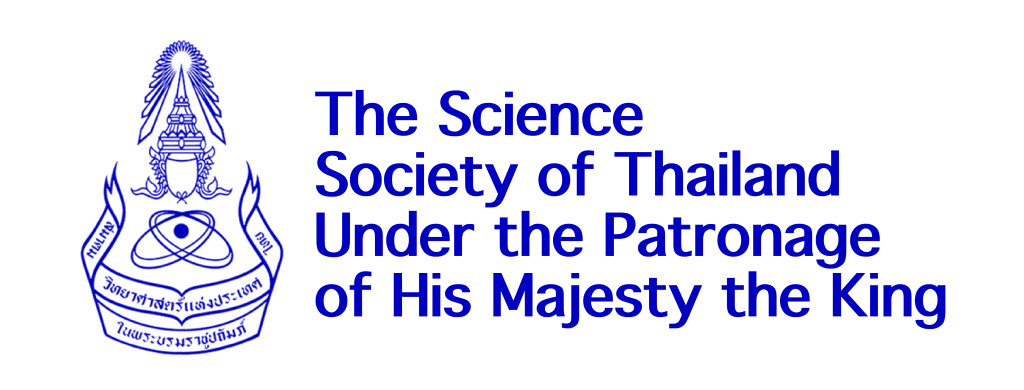Subtotal $0.00

The Science Society of Thailand (SST) is a nonprofit organization that was established in 1948. The SST is the oldest society in Thailand as it has celebrated its Seventieth Anniversary in 2018. The SST is a large organization which undertakes many activities and projects, including promoting public awareness, promoting scientific research, teacher training, student activities and student science projects at all levels of education, honoring outstanding individuals in science and international cooperation. The SST has at present about 4,000 members, most of whom are Individual Lifetime Members, but some are organization members.
During the past decades, the SST has played an important role in stimulating the establishment of various governmental and semi-governmental agencies, including the National Research Council of Thailand, NRCT (in 1956), and the Ministry of Science, Technology and Energy (in 1979).
One of the greatest achievements of the SST must be its success in convincing the Royal Thai Government to approve its proposal to honor H.M. King Raina IV (King Mongkut) as the Father of Science in Thailand, since he accurately calculated the occurrence of a full solar eclipse at Wagor District, Prachuabkirikhan Province on August 18th, 1868. In addition, August 18th is also recognized as National Science Day, providing an important focus for science activities for the public. Thus, a large science exhibition has been arranged in Bangkok every year since 1982, initially by the Ministry of Science, Technology and Energy, but now by the National Science Museum (NSM), a government enterprise under the Ministry’s supervision.
The SST arranges various competitions for school students at six regional centers throughout the country and organizes the nationwide activities for youths and school children during National Science Week, co-sponsored by various agencies. Most activities are in the form of competitions, such as science projects, innovation projects, scientific problem solving, science shows, drawing pictures related to science. The SST has initiated a new Thai Science Camp, at the Royal Command of H.R.H. Princess Maha Chakri Sirindhorn since 2009 to stimulate the interest of youths and school children in science by bringing them in contact with the Outstanding Scientists of Thailand. The society honors the Outstanding Science Teachers to promote teaching profession, and also support The Science Teachers’ Club to organize many activities for primary and secondary schools.
The SST has organized several levels of conferences since 1949; however, the present series of the Annual Congress on Science and Technology of Thailand (STT) started in 1971. The congress is unique in inviting the Science Nobel Laureate and the Outstanding Scientists of Thailand of that year to be keynote speakers in the opening session. Moreover, about 500 research papers are presented in over 15 fields by both local and overseas invited speakers, as well as oral and poster presentations. In 2020, the SST transformed the STT Congress to the STT International Congress in order to cope with academic internationalization.
The SST also publishes a popular science magazine, Wittayasart which is distributed to all members and to some 900 high schools in Thailand through support from the Ministry of Education.
The SST has played another key role in research by publishing a quarterly English-language research journal, the Journal of the Science Society of Thailand since 1975. The journal is regarded as the premier science journal in Thailand after revitalization under the new name of Science Asia in 1999. Science Asia is now bimonthly published and indexed by ISI Web of Science and Scopus. Presently, there are approximately 900-1000 submissions per year. Abo11t 40% of the articles published in Science Asia during 2015-2017 are from abroad.
The SST also promotes excellence by honoring outstanding individuals in science and technology arena of Thailand starting with the establishment of the Outstanding Scientist Award, the first award on the first National Science Day in 1982. This award is the most prestigious research award of Thailand, and the winner receives a plaque of honor from H.M. the King Rama IX. The SST itself also presents awards each year to senior scientists who have contributed to national science development, to outstanding science teachers, and to outstanding science writers and outstanding science media through its Science Writers and Publishers Club.
Winners from the local science project competitions and science camps are selected to compete in international fairs such as Intel Science and Engineering Fair (ISEF) in USA, the International Sustainable World Energy, Engineering and Environment projects (ISWEEEP), Beijing Youth Science Creation Competition, Taiwan International Science Fairs, and a few others. Our outstanding participants in National Science Camps such as Thai Science Camp and junior high school project competition are also given opportunity to attend international science camps in Russia, Korea, India, and China. In 2015, SST and NSM also joined hands in starting annual ASEAN Science Projects Competition to strengthen scientific thinking among ASEAN high school students.
Apart from promoting international activities for youth, the society itself is also members of several international scientific organizations such as the Federation of Asian Scientific Societies and Associations (FASAS) which later merged with the Asian Association of Science Academies (AASA) to become the Association of Academies and Societies of Sciences in Asia (AASSA), the federation of Asian and Oceanian Biochemists and Molecular Biologists, MILSET Asia, and Science Council of Asia